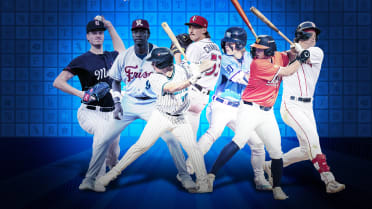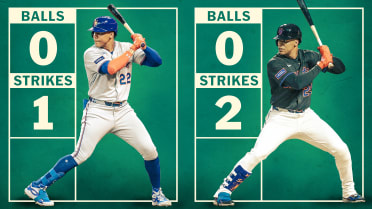NEW YORK -- If the idea of throwing 56 consecutive changeups starts to sound a little ridiculous, there’s no need to temper that incredulity around Tommy Kahnle, the man himself, because he’s actually quick to agree to that point.
“Too many,” Kahnle said with a laugh. “Mix in a fastball, I guess?”
But for three consecutive outings, he has not. Kahnle’s last non-changeup pitch came during Game 2 of the American League Championship Series on Oct. 15, an eighth-inning fastball on which Cleveland’s Brayan Rocchio hit a line-drive single.
Kahnle’s next four pitches that night were changeups -- as were all 26 pitches he threw two nights later in Game 3 of the ALCS, as were all 18 in Game 4, as were all eight he threw on Friday at Dodger Stadium in Game 1 of the World Series, making it 56 consecutive changeups. It’s difficult to find context for a consecutive-pitches feat, but it’s certainly an eyebrow-raiser.
But then, of course, the best player on the planet just has to come along and ruin all the fun.
“It was working well [against] Cleveland,” Kahnle said on Saturday. “I've realized, obviously, yesterday, it kind of reared its naked head, because I was getting away with some where Shohei [Ohtani] hit the double.”
Kahnle had already been thinking that he’d probably need to mix a non-changeup in there -- especially against the Dodgers, who, in addition to having all that offensive firepower, were also the team that employed Kahnle in 2022, making them plenty familiar with his game.
Then, Kahnle got that big neon sign on Friday in his final pitch of the outing (the 56th changeup), which Ohtani rocketed to the wall in right-center field for the double that led to a botched throw from right fielder Juan Soto to second baseman Gleyber Torres. That allowed the Dodgers to erase a one-run deficit in the eighth inning en route to a 6-3 win and a 1-0 series lead over New York.
Still, this is Kahnle’s game.
There have been 257 pitchers this season who have thrown at least 750 pitches and at least one changeup. Only six of them have thrown the changeup more than one-third of the time. Only two of them have thrown the changeup more than half the time. One of them is Trevor Richards, at 53.6%. The other is Kahnle … at 73.1%.
“I’m going to use it,” Kahnle said. “It’s my pitch. It's just basically [about] executing it and not leaving it in bad places to get hit hard.”
While this sort of offspeed-skewed usage isn’t necessarily unique in today’s game, it also seemingly goes against every established notion of how to keep hitters guessing, or off-balance. Heck, it’s even in the name of the pitch, which indicates that it should, well, be a change from something.
But even as hitters know Kahnle’s changeup is coming, they've struggled against it. Opponents hit .157 off Kahnle's changeup during the regular season, and only three hits have come this postseason during that 56-changeup run -- two doubles and one single.
How is it that Kahnle still gets good results with a pitch everyone knows is coming?
“He's really over the top, so [he] rips it and the arm speed throws you off,” Yankees manager Aaron Boone said. “It just doesn't quite get there. For the most part, if he executes his changeup where he wants -- in the strike zone or chase -- and gets the right movement on it, obviously, guys are looking for it, and it's still very hard to hit, just because of the deception and the delivery and the arm speed.”
The first part of Boone’s assessment is actually not entirely accurate, as Kahnle owns the third-lowest release arm angle among the 10 Yankees right-handers to throw at least 500 pitches this season, but Kahnle agrees with the part about his efficacy having something to do with his mechanics.
“Essentially, they think it is more generally from the way I fall off the mound,” Kahnle said. “So when I'm falling off, my release is so late that they think that that creates such a high kind of tumble effect to my changeup.”
That’s interesting, because by the metrics, Kahnle’s changeup isn’t necessarily super unique in its movement profile, and he doesn’t do anything weird with it -- he says he throws just one version of it, with the same relatively normal four-seam grip he’s used since 2011.
It does have a good amount of depth -- 34.5 inches of drop on its way to the plate, on average -- but plenty of pitchers have a changeup with more depth, and while Kahnle’s changeup is a hard one (87.4 mph), there are several guys who get that much depth (or more) at that velocity (or harder).
Where could the mechanics come into play?
Perhaps it’s a trick of the eye -- Kahnle releases the ball from the third-base side of the rubber, but he does so from that arm slot with a violent motion as his body falls off aggressively towards the first-base side, a sequence from which it might be trickier for hitters to anticipate that almost splitter-like movement as the ball comes out of his right hand.
Kahnle also does a really good job of keeping the changeup down and not making mistakes up, so there’s certainly an execution component, too, honed by all this practice throwing changeups and only changeups over the years.
Hitters also know that Kahnle’s fastball is their best chance to do real damage (opponents hit .286 and slugged .536 off his heater this year), and in modern hitting approaches, a guy really doesn’t want to miss that most favorable pitch, especially in a playoff setting.
So maybe it works in Kahnle’s favor that he’s been setting up his next fastball for 56 pitches. The longer this goes, the more a hitter has to know that, seemingly, a fastball must be coming soon, right?
“I think hitters are so geared up where they don't want to get beat with my fastball that they kind of react to the changeup, anticipating the fastball still,” Kahnle said. “It's an interesting approach. But, you know, the guys, I don’t blame them for it, because a lot of times I do give up hard-hit balls on fastballs.”
But at some point, something’s got to give -- and Kahnle hinted that might not be too far off.
“Might surprise people by throwing a fastball first pitch,” Kahnle said.
Do-Hyoung Park covers the Twins for MLB.com.




